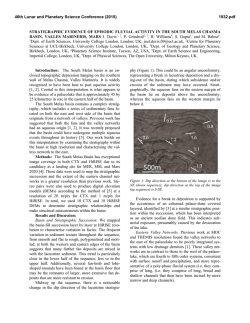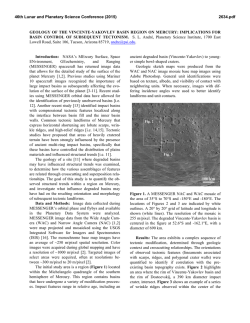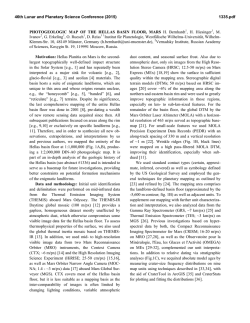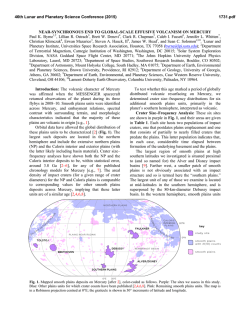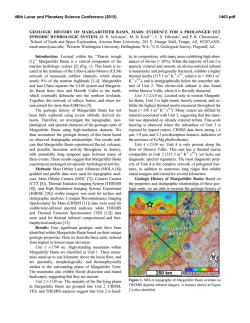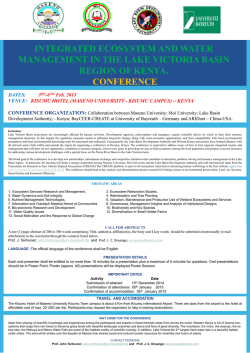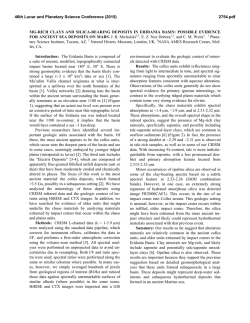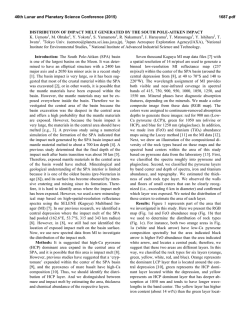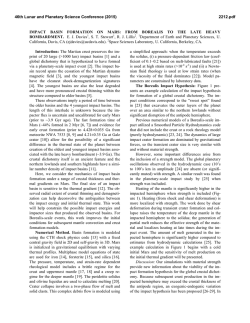
A Geologic Map of the Caloris Basin, Mercury - USRA
46th Lunar and Planetary Science Conference (2015) 2287.pdf A GEOLOGIC MAP OF THE CALORIS BASIN, MERCURY. D. L. Buczkowski1 , B. W. Denevi1, C. M. Ernst1, C. I. Fasset2 and P. K. Byrne3, 1JHU/APL, Laurel, MD 20723, [email protected]; 2Mt. Holyoke College, S. Hadley, MA; 3LPI, Houston, TX. Summary: We present our in-progress 1:5M geologic map of the Caloris basin. This map will refine the stratigraphy of the Caloris basin geologic units and will include a crater classification scheme based on geomorphology and infilling. Introduction: The 1,550 km-diameter Caloris basin, the largest impact structure on Mercury, is a highly complex geologic landform. The basin is floored by light-toned plains [1] that have been determined to be volcanic in nature, and multiple landforms, including volcanic vents and even a possible small shield volcano [e.g. 2,3], have been identified. The basin floor also shows a degree of tectonic diversity that is far greater and more complex than anywhere else on the planet [4]. Also, the nature of the annulus of dark-toned material that surrounds the basin remains unclear [3]. While the hummocks are thought to be ejecta blocks, the smooth, dark, ridged plains interfingering them have been interpreted to be younger than the light-toned plains within the Caloris basin. This would imply a second, plains emplacement event, possibly involving lower albedo volcanic material, which resurfaced the original ejecta deposit. A geologic map of the Caloris basin will serve to synthesize the results of these previous studies into a contextual framework for quickly viewing the thematic research that has been performed on this interesting region. Caloris basin map: In the mapping scheme designed for Mercury, the Caloris basin crosses four quadrangles: H-3 Shakespeare (21º-66°N, 90º-180°W), H-4 Raditladi (21º-66°N, 180º-270°W), H-8 Tolstoj (21ºS -21°N, 144º-216°W) and H-9 Eminescu (21ºS21°N, 216°-288º W). In this mapping effort, we are developing a Caloris basin map that ranges from 0º60°N, 160º-240°W (Fig. 1), covering both the entire basin and its surrounding dark annulus, . This areal extent best summarizes the thematic research of the Caloris basin region. Such region specific maps are common on Mars (e.g. the northern plains [5], the Chryse basin [6], etc.) and can truly focus understanding of a region of interest. We will combining existing high-resolution maps, crater counts, and stratigraphic analyses into a single ArcGIS product to be submitted to the USGS for publication as a finished USGS map. Geologic Units: Two Mercury quadrangle maps based on Mariner 10 data cover the eastern third of the Caloris basin (Fig. 2): H-8 Tolstoj [7] and H-3 Shakespeare [8]. Several terrain units associated with the Caloris basin were identified by [9]. Later, a rockstratigraphic group consisting of several formations was developed during the 1:5M mapping of the H-8 Tolstoj [7] and H-3 Shakespeare [8] quadrangles and then formalized by McCauley et al. [10]. The formations of the Caloris group correspond with the morphological units recognized previously [9] (Fig. 2). Figure 1. Spatial extent of mapping area. Geomorphic map of [20] also shown. Figure 2. MESSENGER mosaic of the Caloris basin overlain by portions of the H-8 Tolstoj [7] and H-3 Shakespeare [8] quadrangles. Odin Formation is light blue; Smooth Plains are pink. The most prominent annular feature surrounding the Caloris basin structure is comprised of smoothsurfaced massifs 1-2 km high and 100-150 km wide. Originally referred to as “mountain terrain” [9], the unit was officially named the Caloris Montes Formation (cm) [7,8,10]. The component blocks were interpreted as uplifted bedrock [9]. 46th Lunar and Planetary Science Conference (2015) The depressions between the massifs of the Caloris Montes are mantled by a undulating to smooth unit called the Nevro Formation (cn) [7,8,10]. McCauley et al. [10] interpreted these “intermontane plains” [9] as fallback material from the Caloris impact itself, but much of the formation may be impact melt ejected from the excavation cavity of the basin [11]. There are two units considered to be facies of Caloris ejecta [7-10]. Hummocky plains [9], consisting of low hills ranging from 0.3-1 km across and up to a few hundred meters high, encircle the basin in a broad annulus that extends up to many hundreds of kilometers from the Caloris Montes. This unit is formally named the Odin Formation (co) [7,8,10]. In some places the Odin hills are concentric to the rim of the Caloris basin, and the spacing between hills can vary greatly. The outer boundary of the Odin Formation is gradational with the younger Smooth Plains Material (ps) exterior to the Caloris basin, which is similarly surrounded by the older, pre-Caloris Intercrater Plains Material (pi). The Van Eyck Formation (cvl) includes a lineated terrain extending radially 1000 km from the outer edge of the Caloris Montes and clusters of secondary craters identified by [7]. The long, hilly ridges and grooves comprising the Van Eyck are sub-radial to the basin proper and are interpreted as ejecta from Caloris secondaries. An extensive plains unit, similar in appearance to the ps material outside of Caloris, covers the floor of the basin. However, the Caloris floor material shows more intense tectonic deformation than the exterior smooth plains, including abundant wrinkle ridges and graben with discrete basin-radial, -concentric, and oblique orientations [4]. In the Tolstoj and Shakespeare quadrangles the Caloris Floor Plains Material (cfp) and the Smooth Plains Material (ps) are mapped as distinct units [7,8]. Unable to discern an unequivocal formation mechanism for the cfp material, the quadrangle maps suggest that it is either volcanic in origin or a thick impact-melt sheet. Discussion: There are two geologic units considered to be facies of Caloris ejecta: the Odin formation and the Van Eyck formation [7-10]. However, Fassett et al. [12] concluded that while the Odin Formation knobs are Caloris ejecta blocks, they may have been mostly embayed and buried by younger volcanic deposits. Conversely, Denevi et al. [3] found conflicting evidence for the origin of the circum-Caloris plains, and determined that the crater size–frequency distributions in these regions may not be meaningful discrimi- 2287.pdf nators of age. They suggested that the higher density of craters on the Caloris rim and ejecta deposits may be the result of non-uniform self-secondary cratering, such as has sometimes been observed on the Moon [13-16]. A second possibility is that a difference in target material properties between ejecta deposits and impact melt could also have resulted in a higher density of craters on the Caloris rim, leading to a false interpretation of greater age. This, too, has been observed in lunar craters [16-19]. Meanwhile, Buczkowski et al. [20] found that the Odin Formation showed two distinct sub-units: a dark sub-unit that has a higher concentration of knobs and a (relatively) bright sub-unit that has fewer and fresher craters (Fig. 2). They suggested that the bright sub-unit represents a volcanic flow younger than and interfingering the knobs and darker flows that represent the Caloris ejecta. By integrating all current data sets, analyses, and maps into a single map product, the persisting question of the nature of the Odin formation can be addressed definitively. Acknowledgements: This work is supported by the Planetary Geology and Geophysics program, grant number NNX14AP50G. References: [1] Murchie S. et al. (2008) Science, 185, 73-76. [2] Goudge T. A. et al. (2012) LPS XLIII, Abstract #1325. [3] Denevi B. W. et al. (2013) JGR, 118, doi:10.1002/jgre.20075. [4] Byrne P. K. et al. (2014) Nature Geosci., 7, 301–307. [5] Tanaka K. L. et al. (2005) U.S. Geol. Survey Map I-2888. [6] Rotto S. and Tanaka K. L. (1995) U.S. Geol. Survey Map I2441. [7] Schaber G. G. and McCauley J. F. (1980) U.S. Geol. Survey, Map I-1199. [8] Guest J. E. and Greeley R. (1983) U.S. Geol. Survey, Map I-1408. [9] Trask N. J. and Guest J. E. (1975) JGR., 80, 24622477. [10] McCauley J. F. et al. (1981) Icarus, 47, 184-202. [11] Spudis P. D. and Guest J. E. (1988) in Mercury, Univ. of Ariz. Press, 118-164. [12] Fassett C. I. et al. (2009) EPSL, 285, 297-308. [13] Shoemaker E. M. et al. (1968) in Surveyor 7 Mission Report. Part 2. NASA Tech. Rep., 32-700, 75–134. [14] Plescia J. B. et al. (2010), LPS XLI, Abstract #2038. [15] Plescia J. B. and Robinson M. S. (2011), LPS XLII, Abstract #1839. [16] Hiesinger H. et al. (2012) JGR, 117, doi: 10.1029/2011JE00393. [17] Schultz P. H. et al. (1977) LPS VIII, 3539–3564. [18] Dundas C. M. et al. (2010) GRL, 37, doi: 10.1029/ 2010GL042869. [19] van der Bogert, C. H. et al. (2010) LPS XLI, Abstract #2165. [20] Buczkowski D. L. and Seelos K. D. (2012) LPS XLIII, Abstract #1844.
© Copyright 2025
